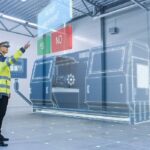An Australian-based advanced software company that develops immersive technology solutions for training and information delivery in the automotive and trade sectors has been getting rave reviews from students and teachers worldwide.
Tradiebot, founded three years ago, develops cutting-edge systems using technology like augmented reality and virtual environments. These systems are integrated seamlessly with automotive businesses such as auto body shops, car rebuilders/customizers and large collision repair centers.
The company has partnered with some key industry players including universities, schools and government bodies to develop industrial innovation and digital transformation through its training platforms.
With an enormous need for new talent in the collision repair industry all over the planet, Tradiebot is succeeding by helping people and organizations to perform a wide range of tasks—from applying primer to a fender all the way to plastic and metal welding techniques.
Beth Rutter, Tradiebot’s director of industry and customer engagement, North America, can see a future where schools or training facilities rely almost exclusively on immersive training.
Simulators won’t replace instructors and I-CAR probably isn’t going to hire robots to teach classes—yet—but augmented reality is here to stay because it’s effective and easy to integrate into any training program.
Training on a virtual system has proven to be highly effective in many industries. Today, bus drivers can learn their routes via augmented reality systems, so your kids won’t be late to school, and doctors now practice on virtual patients in order to improve their skills and techniques.
Tradiebot can provide training for anyone who works in an auto body shop, but currently its main focus is developing virtual reality programs to train entry-level refinish technicians, as well as augmented reality technical information systems and a robotic 3D printing headlight Repairbot.
As the world enters the age of electric vehicles, Tradiebot is prepared to be on the cutting edge when it comes to all of the associated training that will be required.
“We can use virtual training for anything you can imagine, and with all of the processes associated with EVs, our solutions are ideal,” Rutter said. “We can train someone in every aspect of this industry, including auto diagnostics, estimating, aluminum repair, plastic welding and OE repair procedure, in some cases. Our systems work especially well when techs are trained for repetitive tasks.”
A 2019 study on the use of virtual reality (VR) training for soft skills by professional services from Price Waterhouse Coopers discovered when compared to traditional training methods—self-paced online learning and classroom education—VR simulations helped employees become more confident in their ability to perform their jobs, taught them faster and created a stronger emotional bond to training content.
They compared the three main forms of learning—classroom, e-learning and VR training—and found people retained the imparted information more effectively using VR.

Making learning fun and less stressful, Tradiebot will hopefully attract new skilled professionals into the body shop world as a result.
Tradiebot’s smart platforms can fast-track training and hiring, which is more valuable now than ever due to a lack of a skilled and experienced workforce in collision repair, for example.
“The global manufacturing industry is undergoing a transformation with how work is to be done. We need to be smarter, faster and more agile to accommodate the rapid changes in market demand,” according to a company press release. “Tradiebot is developing the technology to adapt, repair and rebuild. Our systems bring knowledge and mastery of skills to your fingertips with a tap on a touch screen. Design detail and sophisticated machines will take the time and tedium out of even the most complex preparation and repair processes.”
By using Tradiebot, job candidates can hit the ground running as opposed to learning on the job. They’re able to absorb the data more quickly and remember it longer, as well as practice without experiencing anxiety.
“By using our systems, students are able to see it, hear it and do it, and by doing all three, they are able to retain the information at approximately 90%,” Rutter said. “Since studies claim that people retain 5% of what we see one hour after it’s presented and roughly 30% after reading it, you can see that the increase in retention is significant with VR.”
Another big part of the Tradiebot approach revolves around the fact it’s
done everything it can to make all of its training modules fun and engaging in order to create a comfort zone to promote learning.
“When the user puts on their gear and jumps into the paint booth, they are intrigued, and once they realize that it’s fun, they are less anxious and more open to learning,” Rutter said.
Will Tradiebot help get more young people interested in becoming collision repair professionals by making training easier, more hands-on and fun?
“If you look at it, the collision repair industry doesn’t do a lot to attract new talent, by starting them out at minimum wage and in many cases, saddling them with major debt from student loans,” Rutter said. “But, if Tradiebot can get students interested in learning through full immersion and virtual reality, the future for this industry will get a much-needed boost with a fresh and skilled labor force.“
Making learning fun and less stressful, Tradiebot will hopefully attract new skilled professionals into the body shop world as a result.
Quelle:
Foto: Students and trainees can learn collision repair techniques from their smartphones and other personal devices while using Tradiebot.


